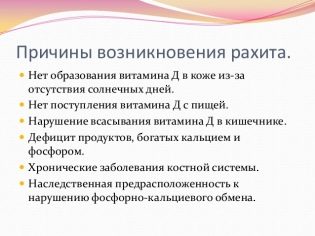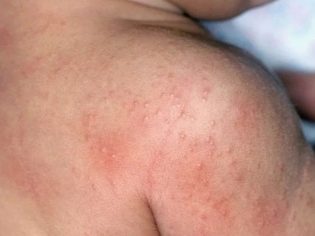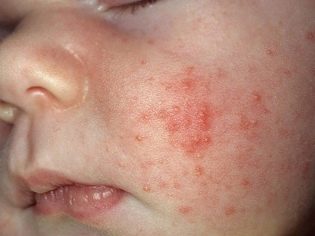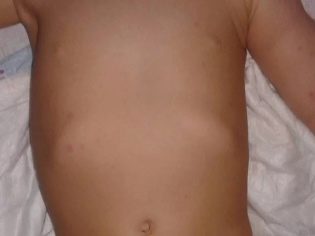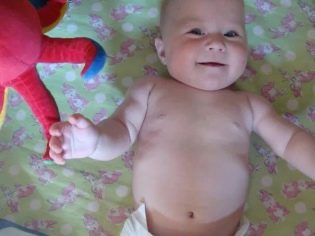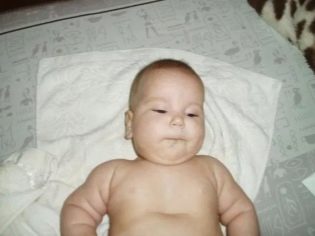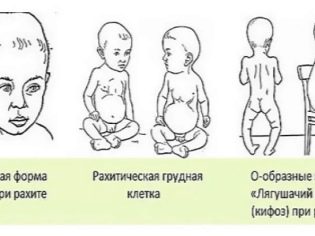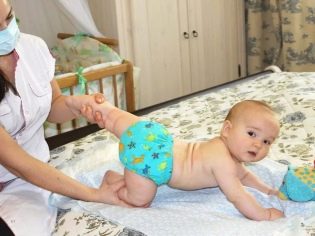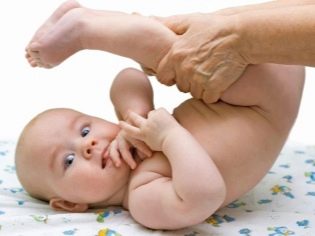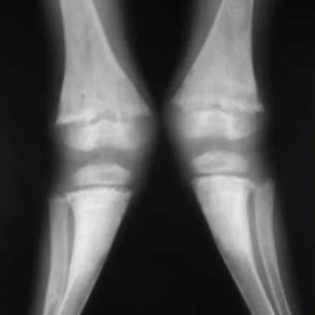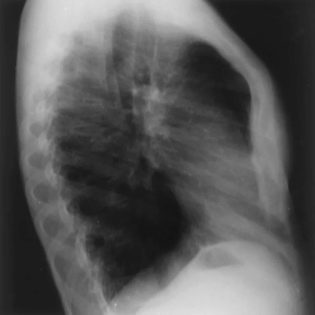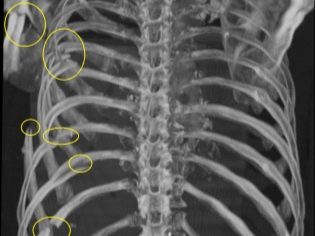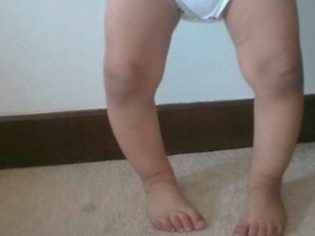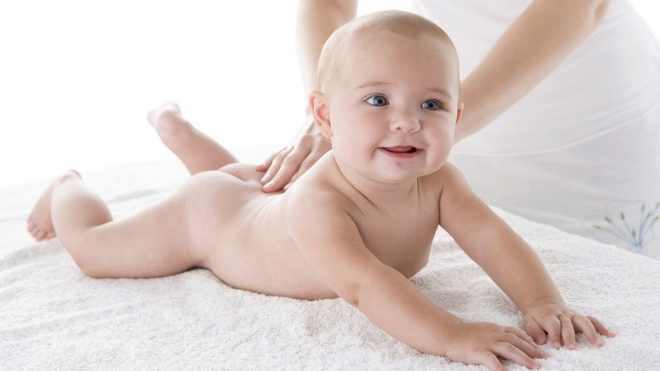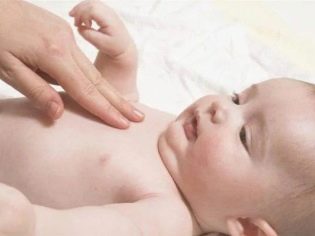Rickets in infants: symptoms and treatment
Quite often, children are registered various disorders of mineral and basal metabolism. They cause persistent functional disorders in babies. One of these diseases is rickets.
What it is?
Systemic disease in children caused by a violation of calcium-phosphorus metabolism is called rickets. The discrepancy between the large need for minerals on the background of the active growth of the child leads to the appearance of a pronounced deficiency of biologically active substances necessary for physiological development. Persistent metabolic disorders lead to the development of the disease in the child - rickets.
It is possible to diagnose the disease in children under one year. There is no exact statistics of this disease. This is usually due to the fact that mild forms of the disease go unnoticed for a long time and do not get into statistical documents when generating medical reports. According to some researchers, the incidence of rickets in the general population ranges from 25 to 60%.
The history of the study of this disease began in the middle of the XVII century. The first indication of this childhood illness was made by anatomist R. Sishop. When forming the name of the disease, the Greek word is used, which means “ridge of the back” in exact translation. This is not an accident. In fact, the name refers to the pathogenesis of the development of the disease and indicates the preferential localization of the pathological process.
For several centuries, scientists have been actively engaged in the study of rickets. And by the end of the 20th century, the medical community already believed that it had all the necessary knowledge about this childhood disease. At this time, there were scientific studies that proved a significant link between the development of the disease and the presence of a baby vitamin deficiency groups.
It is possible to notice interest in this disease much earlier than in the 17th century. The paintings of medieval artists depict kids with a curved chest and a curved spine. It is very likely that the authors wanted to depict children suffering from rickets. In the earlier period of time, people did not know that such a disease exists and with what it is connected. The birth of babies with curvature of the spine meant that it was a “diabolical curse” for the whole family and a very bad sign.
It is important to note that the prevalence of this disease is different. Thus, in adverse conditions of northern cities and countries, a large number of cases of rickets in infants and toddlers of older age are recorded.
Currently, there are more and more scientific studies that indicate that car emissions and air pollution are also factors that influence the increase in the incidence of rickets in children.
The reasons
Already in the 21st century, doctors and scientists agreed that rickets is caused by a lack of vitamin D in the body of a child. Usually, it comes with a certain food that a child eats. Also this useful vitamin is produced inside the body when exposed to sunlight or artificial radiation of the ultraviolet spectrum. Vitamin D or as it is also called "tocopherol" is very important for participation in the calcium-folic metabolism, and therefore vital for all biological reactions.
The following reasons can cause a decrease or a pronounced shortage of this essential substance in a baby:
- Reduced intake with food. This usually happens when not rational, as well as the wrong diet. Infant babies often have problems with vitamin D occurring during the introduction of complementary foods, when the child does not receive all the necessary products.
- Insufficient ultraviolet radiation. Children living in northern cities have a higher risk of developing rickets than their southern little peers. If a child does not walk much on the street, and the children's room is constantly curtained with too thick curtains, then the child often has a pronounced and persistent deficiency of vitamin D.
- Chronic diseases of the gastrointestinal tract. Some of these pathologies, especially enteritis, can disrupt the absorption of vitamins from food during digestion. In infants, such pathologies are usually congenital.
- Various diseases in the future mother. A lack of vitamin D can be observed even in the period of intrauterine development. Usually, chronic diseases of the expectant mother and insufficient intake of vitamins with food lead to this.
- Prematurity Babies born much earlier than the established deadline are at risk for the development of various diseases with impaired metabolism of vitamins. This feature is due to the fact that in a premature baby, many body systems have not yet completely formed.
Anatomical defects that lead to chronic diseases of the gastrointestinal tract, often contribute to the violation of the absorption of vitamin D from breast milk or nutrient mixtures for feeding.
First signs in newborns
Clinical manifestations of rickets manifest in premature babies as early as 1-3 months. They can be expressed in varying degrees. Some babies have adverse symptoms quite brightly. Typically, the diagnosis of the disease in this situation does not cause difficulties for doctors. In this case, the diagnosis of rickets is established in the first 6 months after the birth of the baby.
To suspect the disease in a newborn baby can be the following clinical features:
- Behavior change. The baby becomes easily excitable, reacts excessively violently to any effects facing it. The child's sleep is disturbed. This is usually manifested by the fact that the baby often wakes up in the middle of the night or practically does not sleep. Putting newborn babies to bed with pronounced signs of rickets is quite a challenge.
- The appearance of increased anxiety. The kid becomes very shy. Any sounds can frighten him: the doorbell, the opening or closing of the door, the falling of the object on the floor and others. The child usually reacts to such external stimuli rather sharply: he starts crying hard and even screaming. Often, kids get scared of night sounds, so they also often wake up in the middle of the night.
- Slow physical development. Disorders in the metabolism of calcium on the background of a reduced content of calciferol leads to pathologies in the formation and development of bone tissue. The spine and bones of a child with rickets grow slightly more slowly than in his healthy peers. Doctors usually detect this clinical sign in newborns during regular clinical examinations.
- The appearance of unpleasant smell of skin. Many children's doctors say that the clean and healthy skin of a child "smells" of mother's milk. In the case of rickets, this smell changes and becomes very unpleasant, sour. This is due to the changed chemical composition of sweat due to changes in the content of various substances due to impaired metabolism in the body. Caustic sweat irritates baby's skin, causing the appearance of prickly heat and irritation of the skin.
- Disturbed hair growth on the head. Usually this can be observed in babies in 2-4 months.Excessive sweating causes itching. A small child is still not aware of how he can scratch his skin, so he begins to rub his head on the pillow. This leads to the fact that the hair on the back of his head grows worse.
- Formation of violations of the body structure. This is the initial stage of future pronounced bone pathologies, which will be formed with persistent and in time not eliminated rickets.
To notice the first signs of a newborn baby is quite difficult. Usually these changes are detected by a specialist.
Symptomatology
In its development, the disease goes through several successive stages. The initial period is usually from ½ to 1 month. At this time, the first non-specific clinical manifestations appear, which are often “skipped” by doctors and parents, since they are only slightly expressed. If the course of the disease is subacute, then this period can be 1.5-3 months. At this time, the child does not have any pathological changes in the internal organs.
If this time is missed, then the development of the disease moves to a new level. It is called the height. This time is very unfavorable, since the baby has already formed resistant pathologies in the work of many internal organs and there are pronounced violations of the architecture of the structure of bone tissue. The height of the illness usually occurs after 6 months of a child’s life. The baby has vegetative and neuromuscular manifestations, and rickets of the head and chest begins to form.
Ill child becomes sedentary, practically does not play with your favorite toys or avoids active games. Kids, as a rule, later stand on their feet and begin to crawl late. They are also strongly disturbed by pronounced sweating, hypotension of muscles and ligaments appears. By the end of the year, the child usually appears the first visible signs of osteomalacia (destruction of bone tissue).
Changes in the configuration of the head leads to the appearance of a classic appearance with rickets when there is asymmetry of the head and a much flattened nape. The chest is also involved in the process. The lower third of the sternum becomes depressed, which provokes the appearance of the so-called breast of the shoemaker. In some cases, it can come forward strongly (“chicken breast”).
The pelvic bones are also involved in the systemic pathological process. A pronounced pelvic deformity appears. For rickets is characterized by the defeat of the bones, which grow most actively. They are bent and various deformities appear that cause many orthopedic pathological conditions in a baby. Violations of the bone tissue lead to severe pathologies with teething and the formation of an abnormal bite.
Another classic symptom of the disease is Spine architecture change. The spinal column becomes changed, its various curvatures appear - kyphosis, lordosis and scoliosis. Pathologies that occur in the ligaments against the background of excessive muscle weakness, contribute to the formation of excessive mobility in the joints. Severe hypotonia of the muscles that form the anterior abdominal wall leads to flattening and "spreading" of the abdomen. Doctors also call this symptom the “frog tummy”.
Pronounced bone defects lead to not only orthopedic problems. A flattened chest contributes to the formation of respiratory pathologies and a decrease in the ventilation capacity of the lungs. Squeezing the internal organs causes a disruption in their blood supply, which ultimately leads to the development of multiple chronic diseases in the child. The most frequent pathologies occur in the liver and gastrointestinal tract.
If signs of rickets have been noticed and treatment has been prescribed, then the basic autonomic and neuromuscular disorders begin to pass.
This period of the disease is called convalescence.At this time, as a rule, the child's muscle tone is restored, the work of the joints is normalized, and the general well-being improves. The performance of the internal organs in this period also return to normal. The baby normalized laboratory tests.
Pediatric doctors note that the residual manifestations of the disease remain in the child until the age of 2-3 years. They manifest themselves with slightly reduced muscle tone and mobility in the joints. Other clinical and laboratory changes are not recorded. When properly selected rehabilitation, residual symptoms of rickets disappear, and the child returns to normal life.
Diagnostics
To determine the clinical signs of rickets, even at an early stage, is quite an easy task, as they are usually expressed quite clearly. Every day district pediatricians reveal new cases of the disease in children. The appearance of neurological and autonomic disorders in a child should motivate parents to consult a doctor for advice. The doctor will conduct the necessary clinical examination and recommend the necessary additional tests to establish the correct diagnosis.
In order to establish the severity of impaired metabolism, doctors resort to the following laboratory tests:
- Calcium Determination Normally, it is 2.5-2.7 mmol / l. If its lower normal values are reduced and are 2 mmol / l, then this indicates the presence of signs of impaired calcium-phosphorus metabolism in the child.
- Determination of phosphorus content. Normally, it is 1.3-2.3 mmol / l. With rickets, this figure is significantly reduced. In severe disease, it can be reduced to 0.5 mmol / l.
- Determination of alkaline phosphatase. This biologically active substance is necessary for the transfer and interaction between calcium and phosphorus ions. The normal value of this enzyme is up to 200 U / l. Excess in the analysis above the norm suggests that the baby has signs of irregularities with the exchange of phosphorus and calcium.
When bone defects appear, doctors resort to establishing the degree of their manifestation. To do this, they use the method of radiography of the bones. Using this study, you can determine the density of bone tissue and identify various anomalies that have arisen as a result of the course of the disease. With excessive accumulation of calcium in the bones, radiography shows areas with such seals. Changes in flat and tubular bones are well diagnosed.
With the help of radiography, you can see the specific changes characteristic of rickets. These include: “rachitic beads”, pathological curvatures in the chest and spinal column, “rachitic bracelets” (pathological bone defects in the wrists), as well as deformities of the bones of the lower limbs.
You can also resort to computed tomography. This method also fairly accurately shows all changes that have occurred in bone tissue. Computed tomography has a high resolution, which ensures high accuracy of the results. The method has a significant radiation load, so it should be carried out only under strict indications. There are also contraindications to the study, the presence of which in the child is determined by the attending physician.
To establish the diagnosis should be a comprehensive diagnosis. In some cases, it includes the appointment of several diagnostic tests. Complex clinical situations require a more careful and attentive attitude.
The importance of correct diagnosis is enormous. A timely diagnosis will allow the child to maintain an excellent quality of life and prevent the development of dangerous adverse complications.
Effects
Rickets is a completely harmless disease.It can also be dangerous. With late diagnosis and no treatment, this pediatric pathology leads to the development of adverse effects. These include: curvature of the extremities, impaired bite, chronic diseases of internal organs, marked reduction of tolerance to physical exertion, lag in physical development, disruption of the cardiovascular and respiratory systems.
In order to prevent the development of these consequences of the disease, you should carefully monitor baby's well-being and undergo regular check-ups with a pediatrician. The appearance of the first signs of the disease should be the reason for the appointment of a treatment complex, during which the mandatory monitoring of its effectiveness is carried out.
The positive effect of therapy is manifested by improving the well-being of the child, as well as the normalization of calcium metabolism in laboratory tests.
Treatment
Therapy of rickets is complex. It includes a combination of different therapeutic methods. During the treatment, the condition of the baby is assessed by several medical specialists of different specialties: a pediatrician, a neurologist, an orthopedist, a dentist, an exercise therapy doctor, and a children's massage therapist. Only such a complex therapy can lead to a lasting positive effect of the treatment.
The following methods of treatment are used to eliminate the adverse symptoms of the disease:
- Drug treatment. It comes down to compensation for impaired calcium and phosphorus metabolism. To accomplish this goal, doctors prescribe to a sick child various drugs containing vitamin D in their composition. The selection of drugs and their dosages is carried out taking into account the age of the baby, as well as the severity of his functional disorders.
- Normalization of the daily routine. For the synthesis of vitamin D necessarily need regular insolation. Daily walks in the fresh air are a prerequisite for the treatment of babies who have rickets. For walks, you should choose comfortable clothes so as not to cause hypothermia or overheating of the baby.
Especially effective for the treatment of walking with a child during a bright sunny day.
- Preserving breastfeeding as long as possible. Mother's milk is a unique nutritional product that is created by nature. It contains all the necessary vitamins and trace elements that are necessary for the growth and development of the little man. If it is impossible to save breastfeeding for a number of medical reasons, then you should choose adapted nutritional mixtures for your baby. They must also contain an adequate amount of vitamin D.
- Conducting a massage. Helps to eliminate pronounced neuromuscular manifestations. Special tactics for children's massage can fight hypotonia. Usually, after a massage course, the baby’s well-being improves markedly, and the child begins to feel much better.
- Scheduling supplements taking into account the age of the baby. For babies that have pronounced signs of rickets, doctors prescribe a special diet. It includes the use of products containing vitamin D.
- Physiotherapy. It is a necessary and important component of treatment. Regular classes help the child cope with various neuromuscular disorders, improve posture and help the baby to stand up independently and crawl. Usually classes are held in conjunction with an instructor LFK. However, they can also be carried out at home.
- Treatment of concomitant diseases. Therapy of chronic diseases of the gastrointestinal tract is necessary for the elimination of pronounced metabolic disorders. The pediatric gastroenterologist deals with the treatment of such pathologies.
- Physiotherapy procedures. Usually assigned to babies who do not have contraindications to their conduct.To normalize the calcium-phosphorus metabolism, various methods of ultraviolet irradiation are used. Such procedures are carried out in the clinic, in the office of physiotherapy. The number of visits is determined by the pediatrician.
Medicines
To normalize the level of calcium in a child’s body with rickets, it is necessary to have additional products and drugs containing its active metabolite. calciferol (vitamin D). In pediatric practice, doctors give preference to water-soluble forms. They contain vitamin D in the most optimal condition for intestinal absorption.
One of these drugs is "Akvadetrim." On average, the general course of treatment with preparations containing vitamin D lasts 1-2 months. During this time, normalized indicators of calcium-phosphorus metabolism, as well as improved laboratory performance. After the intensive course of treatment, they do not completely refuse to take vitamin D, but use it in prophylactic dosages.
For the selection of the optimal dosage of water-soluble forms of calciferol should consult a doctor. It is not necessary to select a therapy regimen if the child has already established signs of rickets. Such self-medication will help lead to a pronounced overdose of vitamin D, which is also a very dangerous condition. The doctor selects the optimal dosage of medication taking into account many factors: the child's age, the severity of the disease, and the presence of a child with associated pathologies of internal organs.
If the end of the treatment course falls on the winter season, in some cases, after the end of the main treatment, doctors recommend continuing to take vitamin D for another month to finally eliminate the symptoms of calcium deficiency in the children's body.
Typically, this method of therapy is used in severe and persistent rickets. In order to avoid overdose of calciferol in the child’s body, he is required to determine the level of calcium in the blood several times during the entire treatment.
Massage
For the normalization of reduced neuromuscular tone, as well as improving the overall well-being of the baby, he is prescribed a course of therapeutic health massage. Usually the duration of one procedure in infants is 20-30 minutes. This time is quite enough for a specialist to work through the affected areas of the body.
The course duration is calculated individually by the attending physician, taking into account the age of the baby and the severity of his adverse symptoms of the disease.
During the procedure of therapeutic baby massage specialist conducts several consecutive actions:
- Stroking. This technique helps to calm the child and adjust it to the desired mode. Usually strokes are applied at the very beginning of the procedure. They help the baby feel more relaxed. It is better that during the entire procedure, the mother was nearby. This will help the baby to feel most comfortable.
- Rubbing. This technique has a pronounced effect on the muscles and helps to remove hypotonia. Rubbing helps to improve metabolic processes and activate the blood supply to the internal organs.
- Kneading. This technique has a deeper penetration. It helps to massage the damaged muscles well and eliminates all pathological disorders that occurred in them during the course of the disease. During active kneading there is a relaxation of various muscle groups: arms, legs, tummy, back, neck. All movements of the massage therapist are usually very harmonious, the degree of pressure is small, but quite sufficient for working out the muscles.
- Vibration. It helps to improve metabolic processes, contributes to the normalization of hypotonia, eliminates muscle soreness. This reception can be performed in two modes: intermittently and continuously.The intermittent method helps to improve the tone and reduces muscle atrophy, and continuous - eliminates pronounced spasm and activates the skeletal muscles for making further movements.
Prevention
The prevention of rickets is dealt with by children's specialists in all countries of the world. The disease is of particular importance in the northern states, where the level of solar insolation is quite low throughout the year. In some European countries there are government programs to support families and children. They provide for the free provision to all children of medicines containing vitamin D, for the prevention of rickets.
In our country, there is also a fairly high incidence of this pathology.
Children living in the cold and northern regions should receive an adequate amount of vitamin D from the outside. The main source of it for infants - various correct foods.
A large amount of calciferol is contained in dairy products and egg yolk. Daily requirements for these products are determined based on the age norm.
Toddlers who still do not receive complementary foods should receive vitamin D along with their mother's milk. A nursing mom should remember that her nutrition during lactation is very important. In the composition of the diet of lactating women must be present products that contain a sufficient amount of calciferol. These include: cottage cheese, cheese, dairy products, chicken yolk, meat. A woman during lactation must necessarily include meals containing these products in her daily diet.
Walking outdoors is also important for the prevention of rickets. Ultraviolet radiation helps to produce enough vitamin D inside the child’s body in sufficient quantities. Mommies should go out with the child daily. Especially not to miss good sunny days. Sunlight will help your baby have strong bones and active health for many years.
Active training with a child reduces the likelihood of developing various orthopedic pathologies. To form strong bones, the baby must not only receive good nutrition, but also actively move. Such exercises not only improve the psycho-emotional connection between mother and baby, but also help the crumbs not to get sick with diseases of the musculoskeletal system.
Active games develop physical development and promote good growth.
It is very important to remember that many forms of rickets can be congenital. Planning a healthy pregnancy is very important. The future mother should remember that during the carrying of the baby she should eat efficiently and fully, avoid nervous stress, and also be sure to walk in the fresh air. All pregnant women doctors prescribe multivitamin complexes. Such simple prevention allows expectant mothers to give birth to healthy babies in the future.
About what is rickets in children, see the following video.







